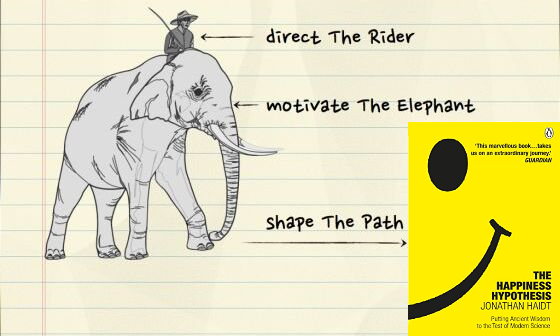“Happiness is not something that you can find, acquire, or achieve directly. You have to get the conditions right and then wait. Some of those conditions are within you. Other conditions require relationships to things beyond you: Just as plants need sun, water, and good soil to thrive, people need love, work, and a connection to something larger“
“The Happiness Hypothesis” by Jonathan Haidt is a book that explores the factors that contribute to happiness and well-being. The book draws on insights from psychology, philosophy, and neuroscience to offer a comprehensive understanding of what makes us happy.
- Happiness Formula:
Happiness = Set Point + Conditions of Life + Voluntary Activities(H = S + C + V)
Let’s break down each component:- Set Point: This refers to our innate level of happiness, which is determined by our genetics and personality traits. Haidt argues that our set point accounts for about 50% of our overall happiness level, and that it is relatively stable over time.
- Conditions of Life: This refers to external factors that can influence our happiness, such as our income, social status, and relationships. According to Haidt, conditions of life account for about 10% of our overall happiness level.
- Voluntary Activities: This refers to the things we choose to do that can impact our happiness, such as hobbies, exercise, and socializing. Haidt argues that voluntary activities account for about 40% of our overall happiness level, and that they are the most important factor we can control.
Haidt suggests that while we may not be able to change our set point or our conditions of life, we can focus on engaging in more voluntary activities that bring us happiness. This might include things like spending time with loved ones, pursuing hobbies we enjoy, and practicing gratitude and mindfulness.
- Retrain the Elephant – A strong metaphor throughout the book.
Rider = Rational Brain; Elephant = Compulsive, Irrational brain.
The elephant represents our automatic thoughts and impulses, while the rider represents our ability to control and direct those thoughts and impulses.
To retrain the concept of “the elephant,” one could focus on developing emotional intelligence and mindfulness practices that help us better understand and manage our emotional responses. This might involve:- Practicing self-awareness: Learning to recognize our emotional triggers and automatic thought patterns can help us identify when our “elephant” is taking over.
- Developing emotional regulation skills: Learning techniques to regulate our emotional responses can help us manage our “elephant” more effectively. This might include things like deep breathing, meditation, or cognitive-behavioral therapy.
- Building empathy and social awareness: Developing our ability to understand and relate to the emotions of others can help us build stronger relationships and communicate more effectively.
- Practicing mindfulness: It help us stay present in the moment and observe our thoughts and emotions without judgment, which can help us better understand our “elephant” and respond more skillfully.
Lasting happiness does not occur through an epiphany. It occurs through focusing on the relationship between rider and elephant and retraining the elephant. You need to consistently act your way to change through tiny habits.
- Coherence is a strong theme throughout. Living coherently leads to happiness and well being. This includes coherence between different levels of your personality, personal values, the environment you live and work within, relationships you have.
When our beliefs, values, and actions are aligned, we feel like we are working towards something meaningful and important, which gives us a sense of fulfillment and satisfaction. On the other hand, when our beliefs, values, and actions are in conflict with each other, we experience cognitive dissonance, which can lead to feelings of confusion, stress, and dissatisfaction. For example, if we value honesty but find ourselves lying to others, this can create a sense of internal conflict and undermine our sense of well-being.
To achieve coherence, Haidt suggests that we need to reflect on our values and beliefs, and work to align our actions with them. This might involve making changes to our behavior, seeking out new experiences that align with our values, or engaging in practices like meditation or therapy to develop greater self-awareness and clarity about our values. - Find your Vital engagement : refers to a state in which we are fully absorbed in an activity that challenges us and allows us to use our strengths and abilities to the fullest extent.
Vital Engagement = Flow + Meaning
According to Haidt, vital engagement is important for several reasons.- First, it provides us with a sense of purpose and meaning, as we feel like we are working towards something important and challenging.
- Second, it allows us to use our strengths and abilities, which can lead to feelings of competence, mastery, and satisfaction.
- Finally, vital engagement can promote feelings of flow, or a state of complete absorption and focus in the present moment.
Haidt suggests that there are several ways to cultivate vital engagement in our lives.- Find activities and experiences that challenge us and allow us to use our strengths and abilities like pursuing a new hobby, learning a new skill.
- Find ways to make our existing activities more engaging and challenging. This might involve setting goals and tracking progress, seeking out feedback and guidance from others, or finding ways to make our work more meaningful and purposeful.
- By cultivating vital engagement in our lives, we can experience greater happiness and well-being, as we feel more connected to our work, our relationships, and our sense of purpose and meaning in life.
- Role of Spirituality: According to Haidt, spirituality can provide several benefits for our mental and emotional health. For example:
- Spirituality can provide a sense of purpose and meaning
- Spirituality can promote feelings of interconnectedness: whether through prayer, meditation, or communal gatherings. This sense of connectedness can promote feelings of social support and belonging.
- Spirituality can promote emotional regulation: Many spiritual practices, such as mindfulness meditation or prayer, can help us regulate our emotions and reduce stress and anxiety.
- Spirituality can promote positive values and virtues: such as compassion, kindness, and forgiveness, which can lead to greater happiness and well-being.
However, Haidt also notes that spirituality can sometimes lead to negative outcomes, such as rigid thinking, intolerance, or dogmatism. Therefore, he suggests that it is important to approach spirituality with an open mind and a willingness to consider multiple perspectives.
Overall, “The Happiness Hypothesis” provides a valuable framework for understanding the complex factors that contribute to happiness, and offers practical strategies for cultivating greater happiness in our lives. It emphasizes the importance of cultivating positive relationships, practicing gratitude and mindfulness, and pursuing meaningful activities that align with our values and interests.
You can check out the book here
To get the free ebook of this wonderful book, you can drop your request in the comment section.


